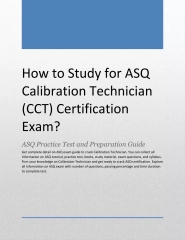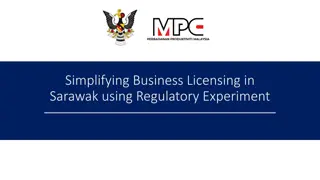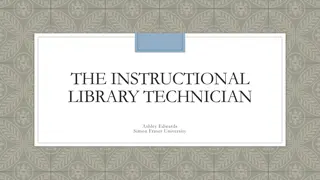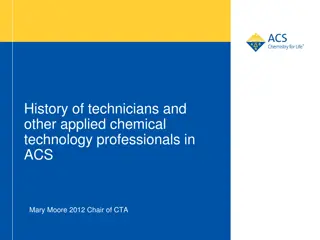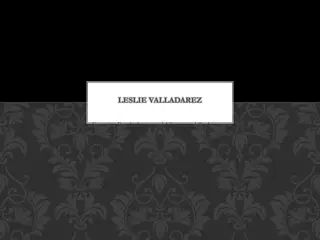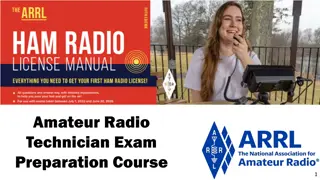Technician Licensing Class
Coaxial cables play a crucial role in transmitting RF signals between radios and antennas in amateur radio systems. Understanding their impedance, connectors, and maintenance is essential for optimal performance. Learn about common coaxial cable types, connectors, handling techniques, and the impact of water contamination on signal quality.
Download Presentation

Please find below an Image/Link to download the presentation.
The content on the website is provided AS IS for your information and personal use only. It may not be sold, licensed, or shared on other websites without obtaining consent from the author.If you encounter any issues during the download, it is possible that the publisher has removed the file from their server.
You are allowed to download the files provided on this website for personal or commercial use, subject to the condition that they are used lawfully. All files are the property of their respective owners.
The content on the website is provided AS IS for your information and personal use only. It may not be sold, licensed, or shared on other websites without obtaining consent from the author.
E N D
Presentation Transcript
Technician Licensing Class Feed Me with Some Good Coax! Section 19 Valid July 1, 2014 Through June 30, 2018
Feed Me with Some Good Coax! T7C12A common use of coaxial cable is to carry RF signals between a radio and antenna. T9B03Coaxial cable is used more often than any other feedline for amateur radio antenna systems because it is easy to use and requires few special installation considerations. Copper Wire Insulation Outside Insulation Mesh T9B0250 ohms is the impedance of the most commonly used coaxial cable in typical amateur radio installations.
Feed Me with Some Good Coax! T9B05As the frequency of a signal passing through coaxial cable is increased the loss increases. The Higher the frequency the more the loss T9B07PL-259 type coax connectors are commonly used at HF frequencies. BNC, Type N, and PL 259 Connectors T9B06A Type N connector is most suitable for frequencies above 400 MHz.
Feed Me with Some Good Coax! N N Male VHF PL-259 Male BNC Male SMA Female SMA Female BNC Female SO-239 Male Female Understand the type of connector on your radio You may need an adapter from your coax connector to your radio Never buy cheap coax, connectors, or adapters
Feed Me with Some Good Coax! T7C11A disadvantage of "air core" coaxial cable, when compared to foam or solid dielectric types is that it requires special techniques to prevent water absorption. core Air core Foam Large coax, with hollow center - a low loss conductor. Air-insulated hard line types of feedline have the lowest loss at VHF and UHF frequencies T9B11 Smaller Heliax solid core
Feed Me with Some Good Coax! T7C09The most common cause for failure of coaxial cables is moisture contamination. Regular BNC, Type N, and PL259 connectors are not water-tight. T9B08Coax connectors exposed to the weather should be sealed against water intrusion to prevent an increase in feedline loss. T7C10The outer jacket of coaxial cable should be resistant to ultraviolet light because UV light can damage the jacket and allow water to enter the cable. T9B10Electrical differences exists between the smaller RG- 58 and larger RG-8 coaxial cables in that RG-8 cable has less loss at a given frequency.
Feed Me with Some Good Coax! T7C02 An antenna analyzer can be used to determine if an antenna is resonant at the desired operating frequency. T7C03In general terms, standing wave ratio (SWR) is a measure of how well a load is matched to a transmission line. T9B01It is important to have a low SWR in an antenna system that uses coaxial cable feedline to provide efficient transfer of power and reduce losses. MFJ-269 SWR Analyzer Impedance Mismatch Causes Reflected Wave
Feed Me with Some Good Coax! T7C04A 1 to 1 reading on an SWR meter indicates a perfect impedance match between the antenna and the feedline. SWR Reading Antenna Condition 1:1 Perfectly Matched 1.5:1 Good Match 2:1 Fair Match 3:1 Poor Match 4:1 Something Definitely Wrong Coax Cable Type, Size, and Loss per 100 feet Loss @ 100 MHz Loss @ 400 MHz RG-58 Small 4.3 dB RG-8X Medium 3.7 dB RG-8U Large 1.9 dB 4.1 dB RG-213 Large 1.9 dB 4.5 dB Hardline Large, Rigid 0.5 dB 1.5 dB Coax TypeSize 9.4 dB 8.0 dB A battery operated SWR analyzer for tower antenna work
Feed Me With Some Good Coax! Coax Cable Signal Loss (Attenuation) in dB per 100ft RG- 174 RG- 213 Loss RG-58 RG-8X RG-6 RG-11 9913 LMR-400 1MHz 1.9dB 0.4dB 0.5dB 0.2dB 0.2dB 0.2dB 0.2dB 0.3dB 10MHz 3.3dB 1.4dB 1.0dB 0.6dB 0.6dB 0.4dB 0.4dB 0.5dB 50MHz 6.6dB 3.3dB 2.5dB 1.6dB 1.4dB 1.0dB 0.9dB 0.9dB 100MHz 8.9dB 4.9dB 3.6dB 2.2dB 2.0dB 1.6dB 1.4dB 1.4dB 200MHz 11.9dB 7.3dB 5.4dB 3.3dB 2.8dB 2.3dB 1.8dB 1.8dB 400MHz 17.3dB 11.2dB 7.9dB 4.8dB 4.3dB 3.5dB 2.6dB 2.6dB 700MHz 26.0dB 16.9dB 11.0dB 6.6dB 5.6dB 4.7dB 3.6dB 3.5dB 900MHz 27.9dB 20.1dB 12.6dB 7.7dB 6.0dB 5.4dB 4.2dB 3.9dB 1GHz 32.0dB 21.5dB 13.5dB 8.3dB 6.1dB 5.6dB 4.5dB 4.1dB 9 9 21 Imped 50ohm 50ohm 50ohm 50ohm 75ohm 75ohm 50ohm 50ohm
Feed Me with Some Good Coax! T7C052 to 1 is the approximate SWR value above which the protection circuits in most solid-state transmitters begin to reduce transmitter power. T7C06An SWR reading of 4:1 means there is an impedance mismatch. T4A05 An in-line SWR meter is connected in series with the feed line, between the transmitter and antenna, to monitor the standing wave ratio of the station antenna system.
Feed Me with Some Good Coax! T9B09A loose connection in an might cause erratic changes in SWR antenna or a feedline readings. Make sure all coax connections are tight to help minimize interference
Feed Me with Some Good Coax! T7C08Other than an SWR meter you could use a directional wattmeter to determine if a feedline and antenna are properly matched. Dual/Twin Needle Single Needle
Feed Me with Some Good Coax! T7C07Power lost in a feedline is converted into heat. T9B04An antenna tuner matches the antenna system impedance to the transceiver's output impedance. Miracle QPak 50 Watt Manual Tuner Icom 7000 with LDG 7000 Auto-Tuner Palstar 1500 Watt Auto-Tuner MFJ-994B 1500 Watt Auto-Tuner
Feed Me with Some Good Coax! T7C01The primary purpose of a dummy load is to prevent the radiation of signals when making tests. Prevents signals from being sent out over the air T7C13A dummy load consists of a non-inductive resistor and a heat sink . 300 Watt Dry Dummy Load Dummy Load-Can 1kw with oil Dry Dummy Load
Take Aways A common use of coaxial cable is to carry RF signals between a radio and antenna. The impedance of the most commonly used coaxial cable in typical amateur radio installations is 50 ohms. Coaxial cable is used more often than any other feedline for amateur radio antenna systems because it is easy to use and requires few special installation considerations. Generally, the loss increases as the frequency of a signal passing through coaxial cable is increased.
Take Aways The PL-259 type coax connectors are commonly used at HF frequencies. A Type N connector is most suitable for frequencies above 400 MHz. A disadvantage of "air core" coaxial cable when compared to foam or solid dielectric types is that it requires special techniques to prevent water absorption. The most common cause for failure of coaxial cables is moisture contamination.
Take Aways Coax connectors exposed to the weather should be sealed against water intrusion to prevent an increase in feedline loss. The outer jacket of coaxial cable should be resistant to ultraviolet light because ultraviolet light can damage the jacket and allow water to enter the cable. The primary electrical difference between the smaller RG- 58 and larger RG-8 coaxial cables is that RG-8 cable has less loss at a given frequency. Air-insulated hard line types of feedline have the lowest loss at VHF and UHF.
Take Aways An antenna analyzer can be used to determine if an antenna is resonant at the desired operating frequency. In general terms, standing wave ratio (SWR) is a measure of how well a load is matched to a transmission line. It is important to have a low SWR in an antenna system that uses coaxial cable feedline to allow the efficient transfer of power and reduce losses. A reading of 1 to 1 on an SWR meter indicates a perfect impedance match between the antenna and the feedline.
Take Aways The approximate SWR value above which the protection circuits in most solid-state transmitters begin to reduce transmitter power is 2 to 1. An SWR reading of 4:1 means there is an impedance mismatch. A loose connection in an antenna or a feedline might cause erratic changes in SWR readings. An instrument, other than an SWR meter, that you could use to determine if a feedline and antenna are properly matched is a directional wattmeter.
Take Aways An in-line SWR meter is connected in series with the feed line, between the transmitter and antenna, to monitor the standing wave ratio of the station antenna system Power lost in a feedline is converted into heat. An antenna tuner matches the antenna system impedance to the transceiver's output impedance. The primary purpose of a dummy load is to prevent the radiation of signals when making tests A dummy load consists of a non-inductive resistor and a heat sink
Element 2 Technician Class Question Pool Feed Me with Some Good Coax! Valid July 1, 2014 Through June 30, 2018
T7C12 Which of the following is a common use of coaxial cable? A. Carrying dc power from a vehicle battery to a mobile radio B. Carrying RF signals between a radio and antenna C. Securing masts, tubing, and other cylindrical objects on towers D. Connecting data signals from a TNC to a computer 23
T9B03 Why is coaxial cable used more often than any other feedline for amateur radio antenna systems? A. It is easy to use and requires few special installation considerations B. It has less loss than any other type of feedline C. It can handle more power than any other type of feedline D. It is less expensive than any other types of feedline 24
T9B02 What is the impedance of the most commonly used coaxial cable in typical amateur radio installations? A. 8 ohms B. 50 ohms C. 600 ohms D. 12 ohms 25
T9B05 What generally happens as the frequency of a signal passing through coaxial cable is increased? A. The apparent SWR increases B. The reflected power increases C. The characteristic impedance increases D. The loss increases 26
T9B07 Which of the following is true of PL-259 type coax connectors? A. They are preferred for microwave operation B. They are water tight C. The are commonly used at HF frequencies D. They are a bayonet type connector 27
T9B06Which of the following connectors is most suitable for frequencies above 400 MHz? A. A UHF (PL-259/SO-239) connector B. A Type N connector C. An RS-213 connector D. A DB-25 connector 28
T7C11 What is a disadvantage of air core coaxial cable when compared to foam or solid dielectric types? A. It has more loss per foot B. It cannot be used for VHF or UHF antennas C. It requires special techniques to prevent water absorption D. It cannot be used at below freezing temperatures 29
T7C09 Which of the following is the most common cause for failure of coaxial cables? A. Moisture contamination B. Gamma rays C. The velocity factor exceeds 1.0 D. Overloading 30
T9B08 Why should coax connectors exposed to the weather be sealed against water intrusion? A. To prevent an increase in feedline loss B. To prevent interference to telephones C. To keep the jacket from becoming loose D. All of these choices are correct 31
T7C10Why should the outer jacket of coaxial cable be resistant to ultraviolet light? A. Ultraviolet resistant jackets prevent harmonic radiation B. Ultraviolet light can increase losses in the cable s jacket C. Ultraviolet and RF signals can mix together, causing interference D. Ultraviolet light can damage the jacket and allow water to enter the cable 32
T9B10 What electrical difference exists between the smaller RG-58 and larger RG-8 coaxial cables? A. There is no significant difference between the two types B. RG-58 cable has less loss at a given frequency C. RG-8 cable has less loss at a given frequency D. RG-58 cable can handle higher power levels 33
T9B11Which of the following types of feedline has the lowest loss at VHF and UHF? A. 50-ohm flexible coax B. Multi-conductor unbalanced cable C. Air-insulated hard line D. 75-ohm flexible coax 34
T7C02 Which of the following instruments can be used to determine if an antenna is resonant at the desired operating frequency? A. A VTVM B. An antenna analyzer C. A Q meter D. A frequency counter 35
T7C03 What, in general terms, is standing wave ratio (SWR)? A. A measure of how well a load is matched to a transmission line B. The ratio of high to low impedance in a feedline C. The transmitter efficiency ratio D. An indication of the quality of your station s ground connection 36
T4A05 Where should an in-line SWR meter be connected to monitor the standing wave ratio of the station antenna system? A. In series with the feed line, between the transmitter and antenna B. In series with the station s ground C. In parallel with the push-to-talk line and the antenna D. In series with the power supply cable, as close as possible to the radio 37
T9B01 Why is it important to have a low SWR in an antenna system that uses coaxial cable feed line? A. To reduce television interference B. To allow the efficient transfer of power and reduce losses C. To prolong antenna life D. All of these choices are correct 38
T7C04 What reading on an SWR meter indicates a perfect impedance match between the antenna and the feedline? A. 2 to 1 B. 1 to 3 C. 1 to 1 D. 10 to 1 39
T7C05 What is the approximate SWR value above which the protection circuits in most solid-state transmitters begin to reduce transmitter power? A. 2 to 1 B. 1 to 2 C. 6 to 1 D. 10 to 1 40
T7C06 What does an SWR reading of 4:1 mean? A. An antenna loss of 4 dB B. A good impedance match C. An antenna gain of 4 D. An impedance mismatch 41
T9B09 What might cause erratic changes in SWR readings? A. The transmitter is being modulated B. A loose connection in an antenna or a feedline C. The transmitter is being over-modulated D. Interference from other stations is distorting your signal 42
T7C08 What instrument other than an SWR meter could you use to determine if a feedline and antenna are properly matched? A. Voltmeter B. Ohmmeter C. Iambic pentameter D. Directional wattmeter 43
T7C07What happens to power lost in a feedline? A. It increases the SWR B. It comes back into your transmitter and could cause damage C. It is converted into heat D. It can cause distortion of your signal 44
T9B04 What does an antenna tuner do? A. It matches the antenna system impedance to the transceiver's output impedance B. It helps a receiver automatically tune in weak stations C. It allows an antenna to be used on both transmit and receive D. It automatically selects the proper antenna for the frequency band being used 45
T7C01 What is the primary purpose of a dummy load? A. To prevent the radiation of signals when making tests B. To prevent over-modulation of your transmitter C. To improve the radiation from your antenna D. To improve the signal to noise ratio of your receiver 46
T7C13What does a dummy load consist of ? A. A high-gain amplifier and a TR switch B. A non-inductive resistor and a heat sink C. A low voltage power supply and a DC relay D. A 50 ohm reactance used to terminate a transmission line 47


